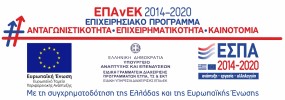GET successfully completed the emblematic project of the Environmental Observatory of the Municipality of Agrinio. The project was included in the “Digital Strategy of the Municipality of Agrinio 2019-2024” and the main “Priorities of the National Digital Strategy in the framework of the Regional Operational Programs of the NSRF 2014-2020”, and included the creation of an Environmental Observatory, in order to strengthen the administrative capacity in environmental monitoring issues, while disseminating information to the public to raise awareness and participation in public life and the political process.
The right of access to environmental information is a key prerequisite for sustainable development as environmental policies must be based on the right information of citizens in order to be effective.With the creation of the Environmental Observatory, the Municipality of Agrinio achieves:
- Systematic updates on the current and desired state of the environment.
- Dynamic monitoring via air quality sensors, water sensors and satellites.
- Citizens’ participation in decision-making through participatory planning processes.
The solution of the Environmental Observatory of the Municipality of Agrinio is essentially the combination of 6 plus 1 application from GET’s Smart City portfolio.
The central pillar of the solution is the Spatial Data Infrastructure (SDI), which is the basis for the creation of the Environmental Observatory of the Smart City. This is the central hub for collecting, controlling and managing of all necessary geospatial reference data. The implemented solution is an open software, cloud-based platform that allows the connection, communication and feedback with the vertical applications of the Smart City of the Municipality of Agrinio providing central information management and common operational picture, as well as the dissemination of information freely to the Administration, citizens and professionals in accordance with the standards set by the Inspire Directive.
The individual systems (vertical applications) that compose the Environmental Observatory of the Municipality of Agrinio are:
- The Air Pollution Monitoring System. This is the vertical application of Air Pollution Monitoring – GET AIR, which consists of a network of low cost IoT sensors and a web platform for providing open air quality data in real time, based on Free Open-Source Software (FOSS) for the analysis and the presentation of information. The solution is completed by mobile application for the direct information of the citizens.
- The Water Quality Monitoring System. This is the vertical application of Water Quality Monitoring – GET WATER QUALITY, which consists of a fixed system of measurement and telecommunication of the quality parameters of Trichonida and Lysimachia lakes and a web platform Free based on Free Open-Source Software (FOSS) for the analysis and the presentation of information. The measured parameters include pH, ORP, Conductivity, TDS, TSS, Dissolved Oxygen, Chlorophyll, Algae, Temperature, Salinity and Turbidity. The web platform allows long-term monitoring and identification of trends and problems. The data is collected on the platform in almost real time (up to an hour) and then checked, analyzed and presented through a modern geospatial web environment. The information is freely provided to the citizens and to the competent services of the Municipality with the use of open standards, in favor of the transparency and the protection of public health.
- The Monitoring System with the Use of Satellite Data. This is the vertical application for Monitoring Environmental Indicators using Remote Sensing (GET EO Environmental Monitoring), which is implemented through a web application, based on Free Open-Source Software (FOSS) for direct access to Sentinel satellite data of the Copernicus system. The system, combining the use of satellite data with machine learning and artificial intelligence techniques, enables the comparison of satellite images and remote sensing indicators for the same area but at different times, while it also allows the detection of changes in Land use.
- The Performance Evaluation System using Quantitative Indicators (KPI’s). This is the vertical application of Performance Indicators for Sustainable Smart Cities of the ISO 37100 Series (GET ISO FOR SMART CITIES), which monitors the performance of the city in domains such as economy, environment, green, energy use, education, adequate housing, social cohesion and population change, sports and cultural facilities, telecommunications, transport and cleanliness. Regarding the calculation and integration of monitoring indicators, they allow the documented monitoring / evaluation of the situation in the Municipality but also the evaluation of its operational function in the above mentioned domains using measurable and quantifiable data. The indicators were calculated based on the available data of the Municipality or other services (ELSTAT, RIS), which were collected, checked and processed and then presented in a web application in the form of interactive graphs and maps.
- The Open Environmental Data Portal. This is the Central Data Dissemination Subsystem of the Smart City Observatory (GET Open DATA). The development of the Portal is based on the use and configuration of Free Open-Source Software (FOSS) following standards and rules of interoperability. Through the Portal the public data of the Municipality (descriptive, geospatial & environmental data and accompanying documents, environmental studies together with the relevant legislation, management plans, research projects), become free and available to everyone, without restrictions of intellectual or industrial property rights, and using open, structured, and machine-readable formats. Finally, real-time representations (e.g. graphs, pies, time series) of data are provided, without the need to save them.
- The Communication and Participatory Spatial Planning Platform. This is the vertical application of Participatory Planning (GET PUBLIC PARTICIPATION), which concerns the development of a web platform for the communication between Municipality – Citizens and for participatory spatial planning. With its use, the Municipality shares information regarding the planning of the city’s projects, asking citizens to participate and collectively shape the characteristics of the projects and interventions in real time. Citizens have the opportunity to share their views, approve or disapprove of a plan, in a structured, efficient and usable way by the municipal authorities. In addition, through the platform, the interventions can be prioritized, but also the opinion of the participants, who will be invited to participate in all stages of the process, can be weighed thus supporting multi-criteria analysis techniques.





